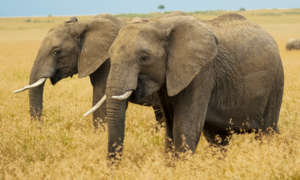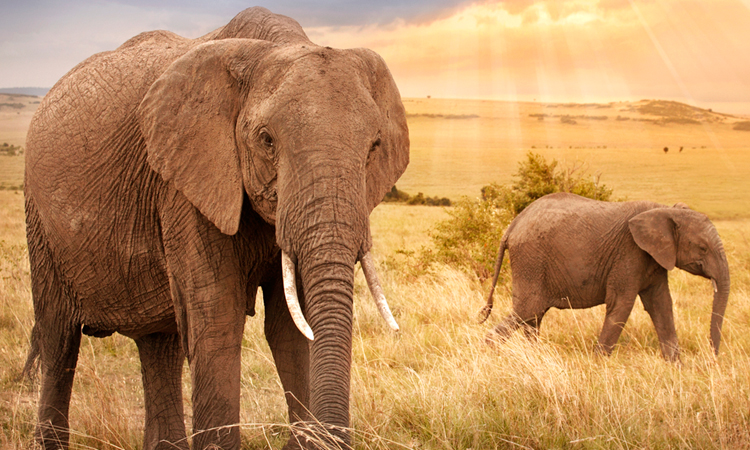“Animals can teach us more than you think. In many ways, they are messengers and healers.”
-Rose Caiola
A protective gene provides new insights on fighting cancer in humans
The bigger the animal, the greater the risk of cancer. That’s because larger animals have more cells that could mutate and tend to have long life spans – cancer incidence increases with age. But one of the most massive land animals on Earth defies this standard. Only about five percent of known elephant deaths are associated with cancer, significantly lower than the rate of 11 percent to 25 percent for humans.
Scientists have long been puzzled by this phenomenon because elephant longevity is similar to that of humans – about 70 years. Elephants also have about 100 times as many cells as people do, thus greatly expanding the number of mutable targets.
 Finally, this mystery may have been solved. According to a study recently reported in the Journal of the American Medical Association, African elephants have 20 copies of a gene that encodes a tumor-suppressing protein known as p53. Humans only have two. Underscoring the importance of p53 is the fact that people with Li-Fraumeni Syndrome, who have only one active copy of p53 instead of the usual two, have more than a 90 percent chance of developing cancer.
Finally, this mystery may have been solved. According to a study recently reported in the Journal of the American Medical Association, African elephants have 20 copies of a gene that encodes a tumor-suppressing protein known as p53. Humans only have two. Underscoring the importance of p53 is the fact that people with Li-Fraumeni Syndrome, who have only one active copy of p53 instead of the usual two, have more than a 90 percent chance of developing cancer.
These results are the fruits of a unique collaboration between the Huntsman Cancer Institute of the University of Utah, Primary Children’s Hospital, Utah’s Hogle Zoo – all in Salt Lake City– and the Ringling Brothers Center for Elephant Conservation. In an experiment, the research team subjected elephant and human white blood cells to radiation that can damage DNA and trigger cancer. The researchers expected faster repair of the exposed elephant cells, due to the greater presence of p53. But the opposite happened; the irradiated elephant cells died at a much faster rate than the human cells.
This may sound like a bad outcome, but it actually serves as an effective deterrent to cancer progression. Eliminating damaged cells faster helps lower the risk that a cancer-causing mutation will replicate itself.
Dr. Joshua Schiffman, a pediatric oncologist at the Huntsman Cancer Institute who was involved in the experiments, notes, “If you kill the damaged cell, it’s gone, and it can’t turn into cancer.” Schiffman adds, “This may be more effective of an approach to cancer prevention than trying to stop a mutated cell from dividing and not being able to completely repair itself.”
 Elephants aren’t the only creatures whose genetic profile lowers cancer risk. Bowhead whales may be an even more remarkable example. During a series of attempts to induce malignancy in the cells of these mammals at the University of Rochester, New York, not a single instance of cancer was reported. Genome mapping of the whale cells revealed mutations that help prevent DNA from being damaged and progressing to a cancerous state.
Elephants aren’t the only creatures whose genetic profile lowers cancer risk. Bowhead whales may be an even more remarkable example. During a series of attempts to induce malignancy in the cells of these mammals at the University of Rochester, New York, not a single instance of cancer was reported. Genome mapping of the whale cells revealed mutations that help prevent DNA from being damaged and progressing to a cancerous state.
On the opposite end of the size spectrum, the naked mole rat also has an impressive anti-cancer resume. While small rodents in general are very likely to get cancer, decades of study have yet to reveal a single cancerous cell in this homely critter. Biology professor Dr. Vera Gobunova, who has studied mole rats in her lab at the University of Rochester, found that they produce a special molecule called hyaluronan that prevents tumor development. Hyaluronan is located in the spaces between cells, serving as a roadblock that prevents a mutated cell from dividing and thereby halts cancer in its tracks.
Oncologists are hopeful that findings in cancer-resistant animals will help them develop tactics for creating new treatments for humans. Currently under investigation, for example, is a drug called Nutlin that somewhat mimics the elephant’s protective mechanism; it helps preserve p53 to keep it viable for blocking tumor development. Treatments such as this may be especially valuable one day for treating pre-malignant conditions and preventing progression to a full-blown cancer.
Other life forms may offer many more insights that could enhance quality of life in people. Craig Dinsmore, executive director at the Hogle Zoo, says, “The animal kingdom undoubtedly holds information that could help lead to cures for many human illnesses.”



